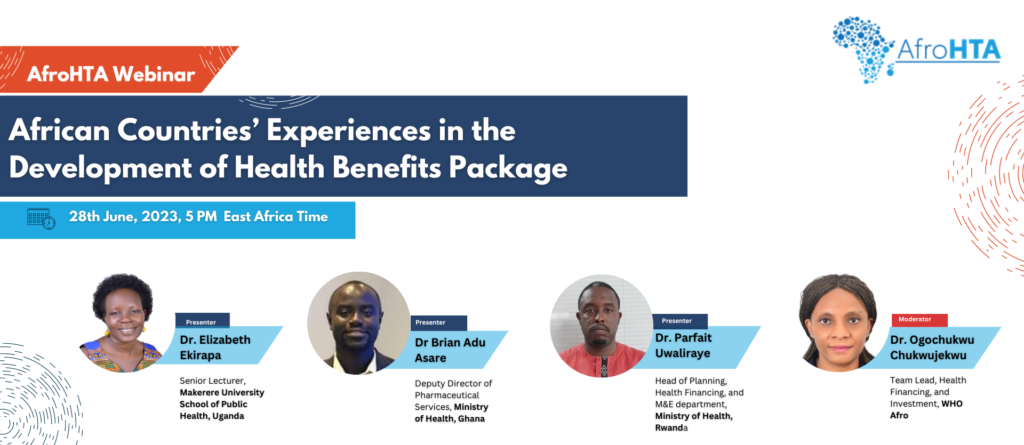
African Countries’ Experiences in the Development of Health Benefits Packages
The growing global commitment to universal health coverage (UHC) has raised a critical question on what services should be made available and under what conditions. This has led countries to focus on developing/updating a set of services that can be feasibly financed and provided given their current circumstances. This set of services is commonly known as a health benefits package (HBP). Low- and Middle-income countries (LMICs) are more disadvantaged than high-income countries in providing more comprehensive health services due to their limited resources. The limited resources have necessitated several African countries to consider a more explicit evidence-informed deliberative process to aid in prioritizing which services to pay for, to whom, and at what cost.
The AfroHTA network hosted a webinar to explore African countries’ experiences developing and refining the Health Benefits Packages to support their commitment to UHC. The webinar brought together experts in health economics to share experiences from Rwanda, Uganda, and Ghana.

Here, we summarize key learnings from the webinar.
The development processes
The Ministry of Health led the process of developing benefits packages by establishing a task force/committee to coordinate the process. The task force ensured it engaged stakeholders such as policymakers, development partners, civil society organizations (CSOs), agencies such as purchasers, providers, representatives of public health facilities, professional associations, academia, the private sector, and patient associations representatives.
Enablers
The following factors contributed to the success of developing and implementing benefits packages across the three countries:
The development of policies and legal frameworks: A vital step in establishing a health benefits package is establishing a policy and a legal framework. For example, Uganda, Rwanda, and Ghana had no policy to aid in developing a benefits package. Where they did exist, they needed to be more comprehensive or updated, prompting the respective Ministries of Health to collaborate with stakeholders to develop policies and guidelines to ensure sustained support for HBP implementation.
Institutional arrangement: A structured and functional organizational arrangement with clear mandates on developing and refining the health benefits package is effective in fastening the development process. This reduced the conflict of interest between the purchaser and the provider by enabling constant stakeholder engagement and reaching a consensus.
Stakeholder participation: The involvement of diverse actors in developing and implementing of benefits packages enabled comprehensive consultations and sufficient input which created a sense of ownership and facilitated smooth implementation.
Explicit evidence-informed criteria: Enable the application of value metrics while developing benefits packages. In Rwanda, what to include in the benefits package considered: – the impact of health problems as measured by financial cost, morbidity, mortality, or their combination; the degree to which the disease affects vulnerable populations; cost-effectiveness; the severity of the disease; budget impact; and political and emergency considerations. In Uganda, the inclusion criteria included: – cost-effectiveness, disease burden, equity, alignment with national health policy guidelines, and feasibility of implementation. In Ghana, they widely used priority-setting tools such as HTA to develop their benefit package and among the criteria considered was equity, burden of disease, and cost-effectiveness.
Leadership: Supportive leadership is critical to successfully implementing the benefits package. The MoH’s willingness to spearhead the process and engage different actors within the health system facilitated the implementation process.
Capacity development: In Rwanda, training on priority setting and defining benefit packages was highlighted as an essential enabler in the process of developing benefit packages.
Barriers
Despite these efforts, the countries faced barriers in developing or implementing packages. These barriers emerged from the following.
Unavailability of local data: limits application of priority-setting criteria during the development of health benefits packages.
The absence of a legal framework: to compel stakeholders to act in a particular manner when evidence is provided to update the benefits package sometimes leads to decision makers not considering the existing evidence whenever they are making decisions on what to include in the benefit package.
Limited technical capacity to conduct the assessment: The lack of training, especially in economic evaluation, poses a challenge in developing health benefits packages.
Political constraints: Getting consensus and political goodwill because of different stakeholder preferences poses a challenge in developing benefit packages.
Lessons Learnt
Various factors influenced the development of health benefits packages in Ghana, Rwanda, and Uganda. To support the development of health benefits packages, countries need a)robust data systems, b) political goodwill to provide leadership in the entire process, c) technical capacity to generate evidence, d) allocation of adequate financial resources to finance the process of implementing the HBP and e) a structured organizational (entities and processes) and institutional (rules and regulations) arrangement to define who does what and when during the process of developing the HBP.
Thank you, Dr. Elizabeth Ekirapa, Dr. Brian Adu Asare, Dr. Parfait Uwaliraye, and Dr. Ogochukwu Chukwujekwu for partnering with us to deliver this insightful webinar
This blog was written by Brian Arwah, Dr. Rahab Mbau and Prof. Edwine Barasa
You can watch the AfroHTA Webinar on African Countries’ Experiences in the Development of Health Benefits Packages here


 Deutsch
Deutsch